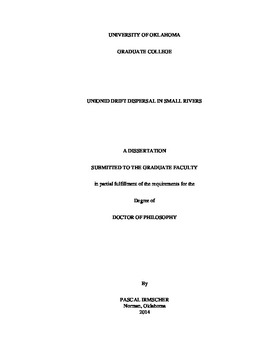| dc.description.abstract | Freshwater mussels (Bivalvia, Unionidae) are a guild of long-lived, burrowing, sedentary, filter-feeding animals that typically occur in dense aggregations called mussel beds. Mussel beds are often patchily distributed, with densely populated areas of a river channel separated by areas where mussels are absent or only sparse. Factors that drive these patchy distribution patterns are complex and highly interactive, and include physical habitat characteristics, food, predation, fish hosts, and dispersal. Of these parameters, dispersal has received the least attention; however, it is likely to be very important for mussel distribution. Unionid mussels have a complex life cycle: while adults are sedentary, mussel larvae are obligate ectoparasites on mobile fish hosts, and the juveniles drift downstream after excystment from the fish host. To date, no one has determined the relationship between juvenile drift dispersal and the distribution of adult mussels in rivers. I developed a conceptual model that includes parameters likely to determine the extent of unionid drift dispersal in rivers. I then tested this model with a series of laboratory experiments and field studies.
In the laboratory, I measured sinking velocities of juvenile mussels of 4 species and those of polymer microparticles that I used as surrogates for juveniles in subsequent experiments. I built a re-circulating flow flume to compare distances that surrogate microparticles drifted over plain gravel versus an artificially created mussel bed. I conducted a field study where I recorded drift distance by releasing and recapturing surrogate microparticles at 5 sites in 2 small rivers in southeastern Oklahoma, USA. I found that sinking velocity values were larger, and drift distance values were smaller than previously reported for juvenile mussels, and that unionid dispersal seems to be limited to a few centimeters to several meters. I also found that mussel shells decreased drift distances compared to plain gravel, and that rapid changes in channel bed slope created hydraulic conditions that favored juvenile settlement in certain areas.
For another field study, I hypothesized that host fish not only serve as dispersal agents for sedentary mussels, but that host movement during infestation with mussel larvae also had an upstream bias that allowed mussels to compensate for downstream displacement with the flow. To test this, I conducted a mark-and-recapture study of host fishes, and found an overall upstream movement trend of 2.25 m. I recaptured most individuals at the transect of their original capture which is in agreement with the Restricted Movement Paradigm. In combination with short drift distances of juveniles, limited host fish movement is an explanation for the patchy distribution of unionid mussels in rivers.
Finally, I examined effects of flow on juvenile dispersal and adult mussel distribution by releasing fluorescent dye into the flow at 6 well-defined mussel bed locations. This allowed me to depict potential pathways of drifting juveniles, and those of suspended particles within the channels. I recorded the spread of dye via aerial photography and geo-referenced images in GIS for further spatial analysis. In addition, I measured water depth as a basis for computing channel bed slope and aspect, and extracted dye greenness values to examine correlations with mussel density and biomass. I found that water depth was not a good predictor, while a channel’s bed slope was a limiting factor to where mussels occurred. Channel bed aspect had no predictive value, whereas mussel abundance was highest for intermediate greenness values, indicating a certain range of flow velocities that selectively promote juvenile mussel settlement and growth, as well as long-term survival of adult mussels in certain areas of a channel.
In summary, I found unionid dispersal to be limited due to restricted host fish movement and short juvenile drift distances. This is in contrast to some findings from computer simulation models, and can be regarded as an explanation for the aggregated spatial distribution that is so typical for unionid mussels. Bed morphology drives local flow patterns which in term determine where juveniles settle and grow into adults. My findings have important implications for future studies of mussel metapopulation structure and the genetic connectivity of populations of highly endangered unionid mussels. They will also support management efforts that aim for better protecting unionid mussels and their riverine habitats, especially in the context of changing flow regimes due to global climate change and the extraction of water for human usage. | en_US |
